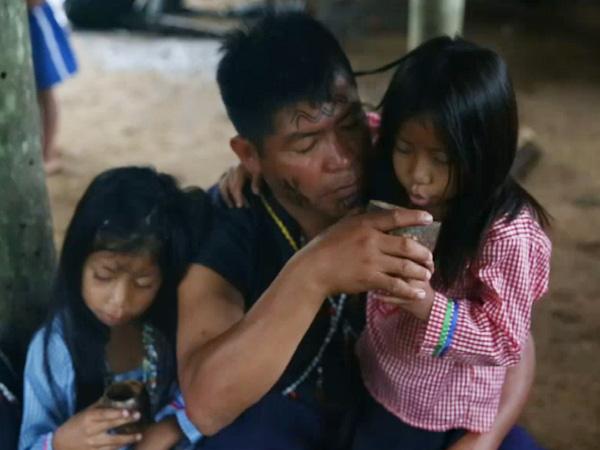エクアドル産、グアユサ茶の将来性は?
- 2014年07月07日 15時53分
- 提供:ナショナルジオグラフィック
Runa LLC is a privately held organic Amazonian beverage company that processes and sells guayusa. The company is based in Brooklyn, New York with offices in Quito and Archidona, Ecuador. It was founded in 2008 by two Brown University graduates, Daniel MacCombie and Tyler Gage. The company operates the world’s only guayusa processing facility in Archidona, Ecuador.[1][2][3]
Runa bagged guayusa launched on the East Coast in October 2010 in natural food stores and supermarkets. In September 2010, the company received its USDA organic certification. A certified Benefit Corporation, Runa purchases guayusa directly from indigenous farmers who own their own land in a model following Fair Trade principles.[4] Runa received its Fair Trade Certification in 2011.
Five years later, Runa now supports more than 2,000 indigenous farming families, employs more than 40 people, and is continuing to demonstrate how sustainable, high-impact business in the Amazon can support producers and connect consumers to ancient traditions.
Contents
[hide]Products[edit]
Runa offers a variety of blends of guayusa for retail sale in the form of energy drinks, bottled iced teas, tea boxes, and loose leaf teas; all of which are USDA certified organic, Kosher certified, Fair Trade certified, and non-GMO certified.
Energy Drinks[edit]
Released in 2013, Runa Clean Energy cans are single ingredient energy drinks. Using highly concentrated guayusa as its base ingredient, the cans contain 120 mg of caffeine and high levels of antioxidants. The energy drinks come in two flavors: sweetened Berry, or unsweetened, zero-calorie Original.
Ready-to-Drink Bottled Tea[edit]
Runa offers 6 flavors of ready-to-drink beverages: 4 lightly sweetened flavors, and 2 unsweetened flavors. The lightly sweetened beverages are sweetened with 14 grams of organic cane sugar and contain 50 calories per bottle, with flavors including Hibiscus-Berry, Lemon-Lemongrass, Mint, and Traditional Guayusa. The unsweetened beverages do not have sugar or artificial sweeteners, are calorie free, and come in Lime and Guava flavors.
Tea Boxes[edit]
Runa tea boxes come in 4 different moderately caffeinated and antioxidant-rich flavors, each box containing 16 infusers. Flavors include Traditional Guayusa, Mint Guayusa, Ginger-Citrus Guayusa, and Cinnamon Lemongrass Guayusa.
Loose-Leaf Tea[edit]
Loose-leaf guayusa comes in 4 different flavors: Traditional Guayusa, Cinnamon-Lemongrass Guayusa, Mint Guayusa, Ginger-Citrus Guayusa. This is guayusa in its purest form.
Guayusa[edit]
Health Benefits[edit]
Guayusa contains the same amount of the world’s most prized stimulant, caffeine, as one cup of coffee. However, guayusa also has another stimulating compound- theobromine. When combined with caffeine it creates a balanced energy effect without any jitters, crash, or jolted buzz. Theobromine is the stimulant found in dark chocolate that offers that pleasant whole body feeling many are familiar with.
Traditional Uses[edit]
Traditionally, indigenous families wake up together at dawn to drink guayusa. They sit around the communal fire drinking gourds full of guayusa until sunrise. During this time, the village elders teach the youth about ancestral myths, hunting techniques, social values, and about what it means to be “Runa” in the indigenous cosmovision. The guayusa ritual continues to be a cornerstone of Kichwa culture, a practice that brings the family and community together around the simple experience of drinking tea.Community shamans, known as yachaks or rukus in Kichwa, will also play a traditional bamboo flute (known as kena) and a two-sided weasel-skin drum, and sing soft rhythmic songs during these early morning hours. The shamans also interpret dreams from the previous night,and make recommendations to guide the community and help them live in harmony with the rainforest. After drinking the first gourds of guayusa, children are often sent to go bathe in the river and receive its strength and cleansing for the day to come.While many of the indigenous communities in the Ecuadorian Amazon grow coffee or tea (plants imported from other parts of the world), guayusa, in contrast, is a native plant of immense cultural importance and mythological significance. Growing guayusa and sharing it with an international community is a powerful way for the indigenous communities to appreciate their culture and recognize its value in the modern world. By drinking guayusa you give these farmers the opportunity to continue living and evolving as Runa.

 写真を拡大
写真を拡大
沒有留言:
張貼留言